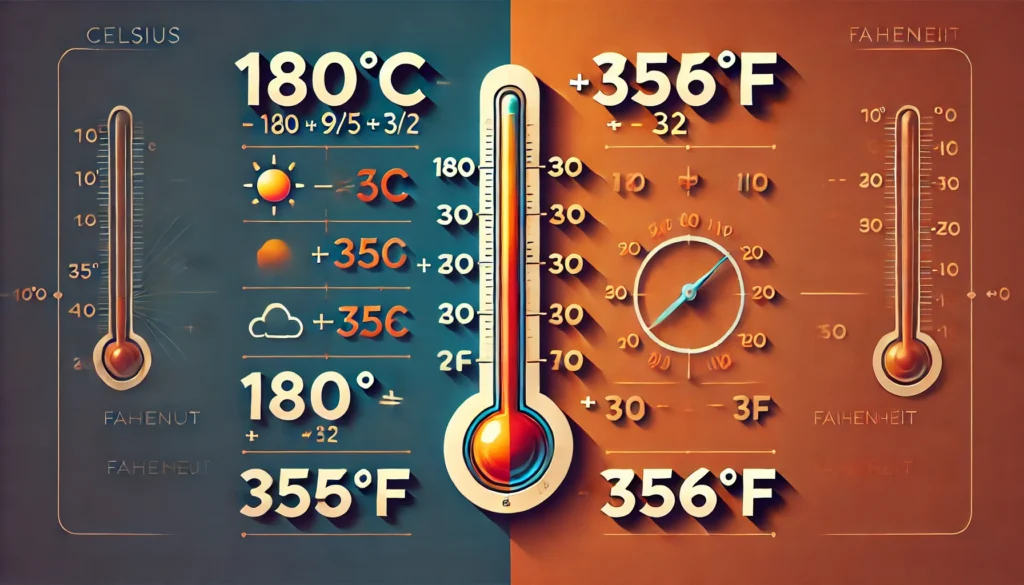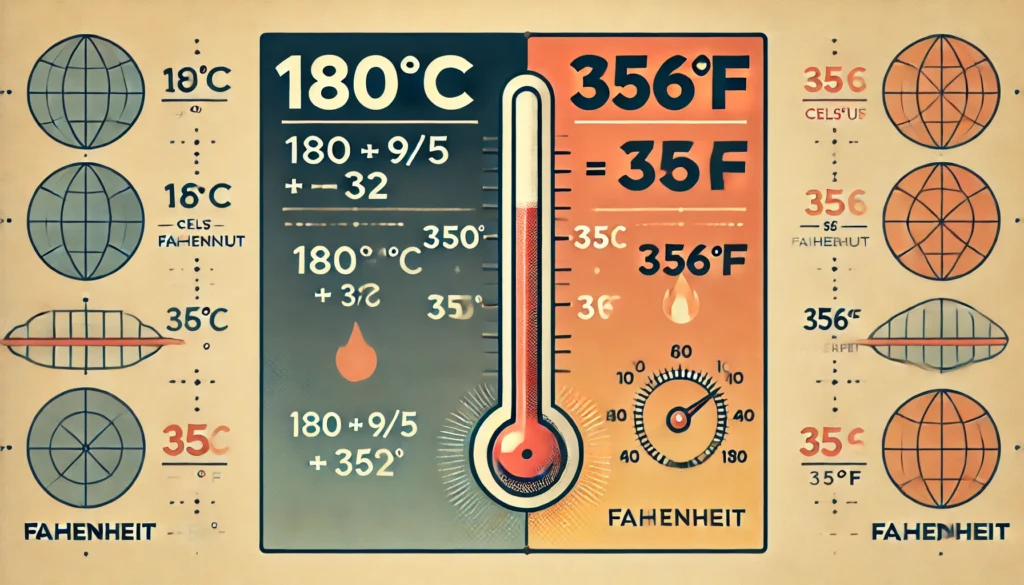Introduction
Temperature conversion is an essential skill, whether you’re cooking, traveling, or working in scientific fields. Different regions and industries use varying temperature scales, making conversions necessary for accuracy. Among the common conversions, one frequently encountered in baking and scientific calculations is converting 180°C to Fahrenheit.
Understanding temperature differences helps prevent mistakes, such as overcooking food or misinterpreting climate conditions. This article explains the process of converting 180°C to Fahrenheit (which equals 356°F), delves into the science behind temperature scales, and provides practical applications for accurate conversions.
The Science Behind Temperature Scales
Temperature measurement has evolved with different scales, the two most widely used being Celsius (°C) and Fahrenheit (°F). Each scale serves specific purposes and is popular in different parts of the world.
The Celsius scale, developed by Anders Celsius in 1742, is based on the freezing and boiling points of water, defined as 0°C and 100°C respectively. This scale is widely used in most countries for weather forecasts, scientific research, and daily applications. The Celsius scale is logical and based on the metric system, making it convenient for scientific calculations.
On the other hand, the Fahrenheit scale, developed by Daniel Gabriel Fahrenheit in 1724, is primarily used in the United States and a few Caribbean nations. In this scale, the freezing point of water is 32°F, and the boiling point is 212°F. While it may seem less intuitive than Celsius, the Fahrenheit scale is more precise for measuring small temperature variations, which is why it remains popular in weather forecasts in the U.S.
The choice between Celsius and Fahrenheit depends on the context. While scientific research and global temperature measurements favor Celsius, Fahrenheit remains useful for regional applications where detailed temperature differentiation is needed.
How to Convert 180°C to Fahrenheit

Converting temperatures between Celsius and Fahrenheit follows a simple formula:
Fahrenheit (°F) = (Celsius °C × 9/5) + 32
Using this formula, let’s convert 180°C to Fahrenheit step by step:
Multiply 180 by 9:
180 × 9 = 1620
Divide by 5:
1620 ÷ 5 = 324
Add 32:
324 + 32 = 356°F
Thus, 180°C is equal to 356°F.
Quick Mental Math Trick
A simple way to estimate conversions without a calculator is to double the Celsius temperature and add 30. While not exact, this trick helps with approximate values:
180 doubled = 360
360 – 4 (small adjustment) = 356°F (close enough for practical use!)
Practical Applications of 180°C in Fahrenheit
Cooking and Baking
One of the most common places you’ll encounter 180°C is in baking. Many recipes, particularly those from Europe and other metric-using countries, specify temperatures in Celsius.
In Fahrenheit-based ovens, 180°C converts to 356°F, often rounded to 350°F for simplicity. This is considered a moderate oven temperature, ideal for baking cakes, cookies, and bread. Using the wrong conversion can result in undercooked or overcooked food, affecting texture and taste.
Industrial and Scientific Uses
In industries that rely on precise heat control, such as metallurgy, chemical processing, and engineering, temperature accuracy is crucial. Incorrect conversions can lead to material weaknesses, incorrect chemical reactions, or even safety hazards. Scientists and engineers working in global collaborations must frequently convert between Celsius and Fahrenheit to ensure consistency.
Weather and Climate Comparisons
For travelers moving between countries using different temperature scales, knowing conversions is useful for interpreting weather forecasts. If you see 180°C on a scientific or industrial heat scale, you’d recognize it as an extremely high temperature for environments but a standard setting for ovens.
Common Mistakes in Temperature Conversion

Misapplying the Formula
One of the most common mistakes is forgetting to apply the correct conversion formula. Some people mistakenly swap the multiplication and division steps, leading to inaccurate results.
Ignoring Oven Temperature Differences
If you’re cooking with a Celsius recipe in a Fahrenheit oven, failing to convert properly can impact your dish. For instance, setting an oven at 180°F instead of 180°C would result in severely undercooked food since 180°F is only about 82°C.
Confusion Between Celsius and Fahrenheit in Travel
When traveling to a country that uses a different temperature scale, mistaking hot and cold temperature readings can be problematic. For example, a traveler from the U.S. might underestimate how hot 40°C is (104°F) and fail to prepare for extreme heat.
Conclusion
Understanding how to convert 180°C to Fahrenheit is practical for cooking, travel, and scientific applications. The formula F = (C × 9/5) + 32 allows easy conversion, and 180°C equals 356°F. Avoiding common mistakes ensures accuracy in daily tasks, from baking to weather interpretation. By mastering simple conversion tricks, you can quickly estimate temperatures and avoid confusion in different settings.
FAQs
Q1: What is the fastest way to convert Celsius to Fahrenheit mentally?
A quick method is to double the Celsius temperature and add 30. For 180°C, (180 × 2) + 30 = 360, then adjust slightly to 356°F.
Q2: Why does the U.S. still use Fahrenheit instead of Celsius?
The U.S. continues to use Fahrenheit due to historical reasons, resistance to change, and familiarity. It also provides smaller, more precise temperature increments for daily weather use.
Q3: How accurate are online temperature conversion tools?
Most online tools are highly accurate, as they use the exact mathematical formula. However, some round temperatures, which can create slight discrepancies in precise applications.
Q4: Can I estimate conversions without using a calculator?
Yes! A rough estimate is doubling the Celsius value and adding 30. It won’t be exact, but it works well for quick approximations.
Q5: What other common Celsius-to-Fahrenheit conversions should I know?
Here are a few:
0°C = 32°F (freezing point of water)
100°C = 212°F (boiling point of water)
200°C = 392°F (common oven setting)
Mastering temperature conversions simplifies daily life, whether you’re baking, traveling, or working in scientific fields








Add comment